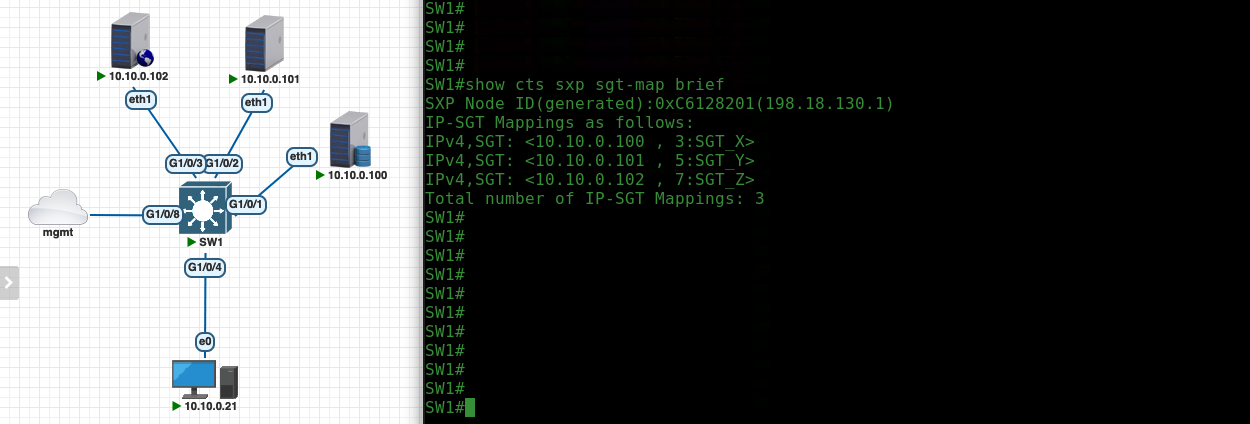Cisco ISE TrustSec
Cisco TrustSec (CTS) is a security architecture that simplifies policy enforcement in network environments by using software-defined segmentation. It employs Security Group Tags (SGTs) to classify network traffic dynamically, enabling granular access control without relying on complex IP-based ACLs. TrustSec uses Cisco TrustSec-capable devices to propagate SGTs throughout the network, ensuring policy consistency.
SGT Exchange Protocol (SXP) is a key component that allows devices incapable of assigning SGTs to participate in the TrustSec architecture by mapping IP addresses to SGTs and sharing this mapping with other TrustSec-enabled devices. This enables a unified and scalable approach to network segmentation and access control.
Configuring TrustSec on ISE
On ISE, add the NAD and enable TrustSec along with the usual Radius configuration, this device will become the Enforcement Point for the TrustSec rules
Next also add the NAD as an SXP Listener Device so it will get updates about our SGT Mappings
Security Group Tag Exchange Protocol (SXP) is a protocol used in Cisco TrustSec to propagate SGT bindings across the network.
After that create some SGTs, here we’ll use SGT_X, SGT_Y, and SGT_Z
Next create two SGACL, one for permit access and the other for deny access
- SGACL (Security Group Access Control List) is a policy enforcement mechanism that applies access control rules based on SGTs rather than IP addresses.
After that define the SGT access policy by creating the SGT Matrix, here we enable access from SGT_X to SGT_Y, but deny it to SGT_Z
- The SGT Matrix is a policy table that maps interactions between source and destination SGTs, specifying the level of access allowed using SGACL.
Next we configure the Policy Sets to dynamically assigns SGT to endpoint
Or we can statically assign the SGT to specific IP Addresses on ISE
Configuring TrustSec on NAD
Before configuring TrustSec, make sure the NAD alrady has radius configuration for dot1x/mab authentication, after then we can put these config on top of it.
1
2
3
4
5
6
7
8
9
10
11
12
13
cts sxp enable
cts sxp default password helena
cts sxp default source-ip 198.18.130.1
cts sxp connection peer 198.18.128.11 password default mode local listener
cts role-based enforcement
aaa authorization network CTS group ISE
cts authorization list CTS
cts credentials id SW1 password helena
radius server ISE1
address ipv4 198.18.128.11 auth-port 1812 acct-port 1813
pac key helena
After config has been applied, NAD will start doing CTS authentication that we can see on Radius Logs
Running “show cts pacs” confirms this process has been complete
PACs (Privilege Authorization Certificates) are secure, cryptographic credentials used in Cisco TrustSec to authenticate and establish trust between network devices, enabling secure propagation of Security Group Tags (SGTs).
Command “show cts environment-data” shows the NAD has successfully downloaded the environment-data which contains the SGTs
Running “show cts role-based permission” shows SGT Matrix rules, these rules are also automatically applied as access-lists
The command “show cts role-based sgt-map all” shows the IP-to-SGT mappings which are obtained from internal sessions or from SXP
Talking about SXP, run “show cts sxp connections” to verify SXP connection to ISE
The SXP status should also be reflected on ISE
To show all SGT Mappings obtained throgh SXP, run “show cts sxp sgt-map”
Testing TrustSec
Here we have devices all in the same subnet, where .100 with SGT_X can access .101 with SGT_Y just fine, but not to .102 with SGT_Z
Modifying SGT Matrix
Now lets add a new SGACL to block traffic on port 443
Here we put the SGACL on matrix from SGT_X to SGT_Z
Run “cts refresh policy” to force the update on the NAD side
And now the .100 client can still ping or access any port on .102, except for port 443






















